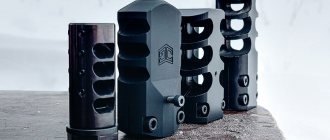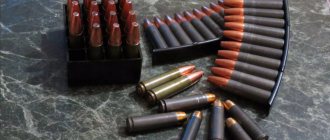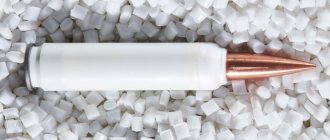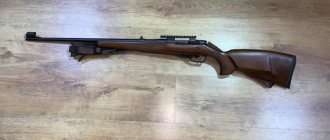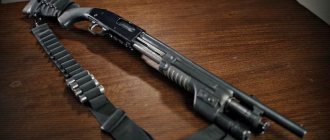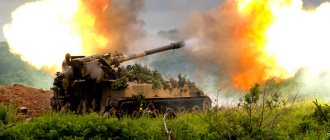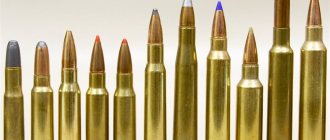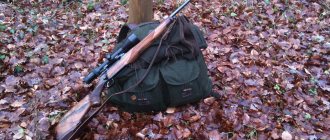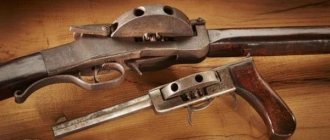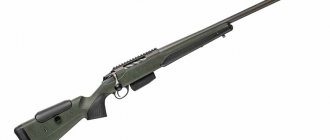Pistol cartridges[edit]
| Name | Bullet | Type of shell | Case length | Rim | Base | Shoulder | Neck | OAL |
| 7 × 20mm Nambu [1] | 7,112 (0,280) | bottleneck without rim | 19,81 (0,78) | 9,12 (0,359) | 8,91 (0,351) | 8,56 (0,337) | 7,52 (0,296) | 26,92 (1,06) |
| 7.5 FK [2] | 7.8 mm (.307) | bottleneck without rim | 27,0 (1,063) | — | 10,8 (0,425) | 10,8 (0,425) | — | 35,0 (1,378) |
| 7.62 × 42 mm | 7,62 | — | 42,0 | — | — | — | — | — |
| 7.65 mm Roth–Sauer [1] | 7,645 (.301) | rimless straight | 12,95 (0,51) | 8,51 (0,335) | 8,51 (0,335) | — | 8,43 (0,332) | 21,34 (0,84) |
| 7.62×25mm Tokarev | 7,798 (0,307) | bottleneck without rim | 24,99 (0,984) | 9,96 (0,392) | 9,83 (0,387) | 9,47 (0,373) | 8,48 (0,334) | 34,29 (1,35) |
| 7.65×25mm Borchardt | 7,798 (0,307) | bottleneck without rim | 25,15 (0,990) | 9,91 (0,390) | 9,78 (0,385) | 9,4 (0,370) | 8,41 (0,331) | 34,54 (1,36) |
| 7.65 mm Mannlicher [1] | 7,823 (0,308) | rimless straight | 21,34 (0,84) | 8,48 (0,334) | 8,43 (0,332) | — | 8,41 (0,331) | 28,45 (1,12) |
| 7.63×25mm Mauser | 7,823 (0,308) | bottleneck without rim | 25,15 (0,990) | 9,91 (0,390) | 9,68 (0,368) | 9,4 (0,370) | 8,43 (0,332) | 34,54 (1,36) |
| 7.65 mm Longue [1] | 7,849 (0,309) | rimless straight | 19,81 (0,78) | 8,56 (0,337) | 8,56 (0,337) | — | 8,53 (0,336) | 30,23 (1,19) |
| 7.65 × 21 mm Parabellum | 7,861 (0,3095) | bottleneck without rim | 21,59 (0,850) | 10,01 (0,394) | 9,906 (0,390) | 9,627 (0,379) | 8,433 (0,332) | 29,84 (1,175) |
| .32 ACP ( 7.65×17mmSR Browning ) | 7,938 (0,3125) | semicolic straight | 17,27 (0,680) | 9,093 (0,358) | 8,585 (0,338) | No data | 8,55 (0,336) | 25,0 (.984) |
| .32 NAA | 7,95 (0,3125) | bottleneck without rim | 17,27 (0,680) | 9,50 (0,374) | 9,50 (0,374) | 9,47 (0,373) | 8,55 (0,336) | 25,0 (.984) |
Veteran caliber 7x57
Telling the story of the creation of this caliber, we evaluate it from the point of view of its possible use in big game hunting.
Reasons for the creation of the 7x57 caliber
Many often ask themselves the question why they suddenly decided to start producing a rifle in the 7x57 mm caliber when the 8x57 mm caliber already existed.
It would be logical to assume that it cost practically nothing to create a 7x57 caliber rifle on the basis of an existing 8x57 mm caliber rifle, which was in service with the German army, the home country of the Mauser brothers, and this in itself was already a kind of guarantee. We cannot ask Paul Mauser this question in order to get from him the only correct answer. He died decades ago. But I’ll risk making a guess without fear of being very wrong. At the end of the 19th century, the company employed outstanding small arms designers of that time. Having created the best powder charge with black powder for the 9.5x60 mm caliber cartridge, they decided to make the same charge in a cartridge filled with nitro powder. As a result, the optimal caliber for such a charge was 7 mm nominal (7.2 mm actual) with a cartridge weight of 9 g, or 139 grains. In addition, it is possible that a kind of impetus for the development of this cartridge was the fact that the patent for the 8x57 mm rifle belonged to the German government. And it did not want to give it up to Mauser. The military, who were categorically against the armies of other countries having these weapons in service, undoubtedly had a hand in this ban. In any case, the designers decided to use equipment for the production of an 8x57 mm cartridge to produce a 7x57 mm cartridge. To do this, it was only necessary to reduce the barrel of the cartridge case from eight millimeters to six. At first, the 7x57 mm caliber aroused greater sympathy than the 8x57 mm: thanks to less recoil, soldiers began to shoot more accurately, and less time was spent on fire training. In addition, the capacity of the cartridge case was greater, and this made it possible to use heavy charges with high efficiency. All this earned the new caliber fame in big game hunting in Africa, when an antelope or gazelle could be felled with one shot. This caliber was used by experienced hunters, such as the German and Dutch colonists. Bell, elephant hunter
One of the most famous elephant hunters is the Englishman Walter Bell, better known by the name “Karamojo” Bell, which was given to him by the aborigines (Karamojo is an area in southern Sudan where elephants are found in abundance).
With his .275 Rigby rifle, which is a British version of the 7x57mm rifle, he has killed over a thousand elephants. It should be noted, however, that he hunted elephants using tactics that allowed him to avoid danger. As can be understood from the name given to him by the aborigines, he hunted a lot in Karamojo. This area is a vast plain, or savannah, covered with long grass, in which buffaloes and elephants love to graze, since there they can find all the food they need. The grass there reaches three meters in height and covers the elephant's head. Bell found a herd of elephants, carefully approached it at a distance of about a hundred meters and climbed onto a ladder carried by his native assistant. From there, he observed the herd, selected the male with the largest tusks, calmly waited for the right moment, and eventually put a bullet between his ear and eye. This is where the elephant's skull is thinnest, and it can be killed with one well-aimed shot. However, for this it was necessary to have a lot of experience, to know the anatomy of an elephant well and to be a marksman. In addition, hunting in Africa requires endurance and resistance to tropical diseases, especially malaria. It was malaria that “sent early retirement” to many white hunters at the beginning of the twentieth century. And if a rifle, with the correct selection of a projectile, can immediately knock down an elephant, then, obviously, it can do the same with thin-skinned animals of smaller weight and size. Here, as with all medium calibers, it is important to choose the right type of bullet for hunting a certain animal in certain conditions. As already mentioned, Bell used a small caliber rifle only when hunting peacefully grazing elephants, unaware of the presence of the hunter. Rifles of 7x57 caliber
As for the choice of weapons of this caliber, it is not particularly wide.
At the same time, there are a large number of inexpensive military rifles that have been removed from service, but are still gathering dust in warehouses, which can be converted into hunting rifles. If you work hard on such a weapon and improve the shooting accuracy, you can get a great rifle. And if, in addition, you lengthen the rifle, it will become an ideal weapon for chasing game. The rifle that many hunters spend their entire lives searching for and never finding. To avoid misunderstandings,
I would like to clarify so that the reader does not misunderstand my story about “Caramojo” Bell. Of course, the 7x57 caliber is not specifically designed for hunting elephants or any other dangerous animals, such as buffalo, lions, bears or tigers. It would be the worst and, I would add, the last nightmare in a hunter’s life if he were to encounter any of these animals with a 7x57 caliber rifle in his hands. I would like to especially note this so as not to listen to unfounded criticism later.
Is it possible to use this caliber in basic types of big game hunting such as stalking and roundup?
Raid
This caliber cannot be called optimal for effective shooting at large animals during a raid hunt due to the fact that animals, frightened by the barking of dogs or the screams of beaters, come out to the hunter in a state of excitement.
However, if you use 175-grain bullets and ignore the mediocre external ballistics that are not so pronounced in this type of hunting, since the shot is fired at a relatively close distance, the use of this caliber is acceptable. It is better to choose European ammunition, since the Americans do not have enough charges of different weights and the choice is generally poor. For example, in the latest catalog for this caliber there is only one type of ammunition, and that with poor characteristics. European manufacturers, and especially RWS, on the contrary, offer up to six types of different ammunition. The best ammunition for hunting large game is German-made cartridges with jacketed bullets that have controlled expansion. Pursuit
Caliber 7x57 demonstrates its best qualities in this type of hunting thanks to the reliability of the shot and the flatness of the trajectory when shooting at medium distances. Add to this the tolerable recoil, allowing the shooter to show off all the marksmanship he is capable of. The 7x57 caliber is ideal for hunting in the mountains, since existing rifles of this caliber are lightweight. When hunting thin-skinned animals of small stature and weight, light cartridges of this caliber put the game down at medium distances. At long distances - from two hundred meters - medium-weight cartridges have proven themselves to be excellent. The heaviest cartridges are good to use when hunting large animals weighing four hundred kilograms and above. The 7x57 caliber can show quite decent results when shooting at long distances. But for this you need to know well the features of the flight trajectory of bullets. Rifles of this caliber, thanks to fine-tuning and hand-assembly, can become unusually effective weapons with the right choice of ammunition. And today there is a wide variety of them for 7 mm caliber. The 7x57 mm caliber is worthy of the highest rating. He undeservedly lost popularity. Potential buyers often try to find in rifles of other calibers what the 7x57mm has offered for over a hundred years. This caliber has a lot to be proud of and a lot to offer. For a long time, rifles of 7x57 mm caliber were in service with the armies of many countries, but were replaced because other calibers better suited military needs. However, this has nothing to do with hunting. The undeservedly forgotten caliber 7x57 mm should take its rightful place among hunting weapons.
Links[edit]
- ^ abcdefgh i Barnes, Frank K., ed. Amber, John T., Cartridges of the World
(3rd edition), (DBI, 1978), ISBN 0-695-80326-3 - "Cartridge". fkbrno.com
. Archived from the original on February 20, 2022. Retrieved February 13, 2022. - Jump up
↑ Barnes, Frank C. (1993).
Bussard, Mike (ed.). Cartridges of the world
(7th ed. and additional ed.). Northbrook, IL: DBI Books. item 382. ISBN. 0-87349-145-9. OCLC 29683953. - ^ abcdefghijklmnopq SAAMI: Voluntary Industry Performance Standards for Centerfire Fire Pressure and Velocity for Use by Commercial Manufacturers
- 277 SIG FURY SAAMI Figure
- Data" 7mm Shooting Times Westerner" from Accurate Powder
- Barnes, Frank S. (1997) [1965]. McPherson, M. L. (ed.). Cartridges of the World (8th ed.). DBI Books. pp. 355, 374. ISBN 0-87349-178-5.
- "7×33 Sako" (PDF). CIP May 15, 2002. Retrieved October 8, 2020.
- Barnes, Frank S. (2006) [1965]. Skinner, Stan (ed.). Cartridges of the World
(11th ed.). Iola, WI, USA: Gun Digest Books. pp. 384, 408. ISBN 0-89689-297-2. - Barnes, Frank S. (2006) [1965]. Skinner, Stan (ed.). Cartridges of the World
(11th ed.). Iola, WI, USA: Gun Digest Books. pp. 353, 375. ISBN 0-89689-297-2. - ↑
.300 Weatherby Magnum at Accurate Powder. Archived August 27, 2010, at the Wayback Machine. - Cartridge dimensions on Steve's pages
- "30 BR" (PDF). CIP May 25, 2011. Retrieved October 8, 2022.
- "300 Precision Rifle Cartridge [300 PRC]" (PDF). SAMI. June 13, 2022. Retrieved October 13, 2022.
- "300 HAM'R [300 HAMR]" (PDF). SAMI. January 20, 2022. Retrieved October 13, 2022.
- CIP: 7.62×53R
- CIP: 7.62×54R

